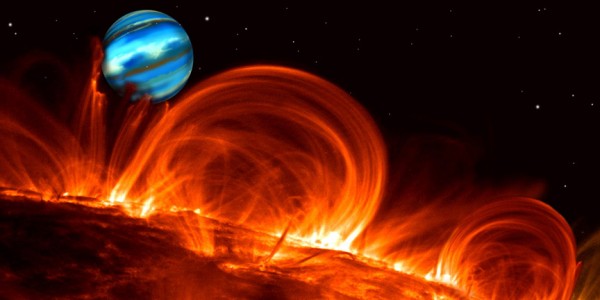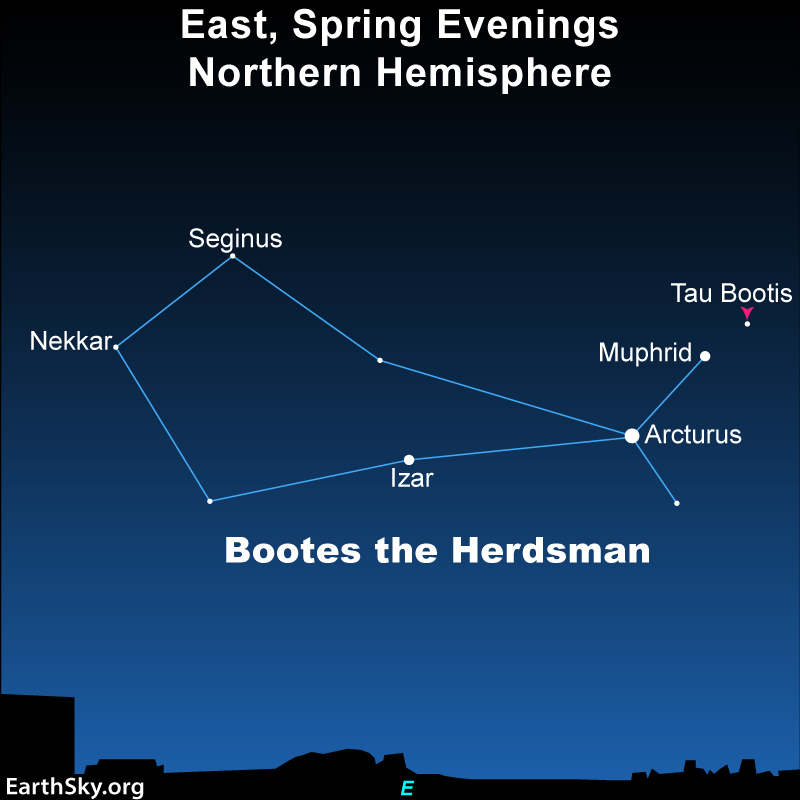
Tau Boötis pole flip
March 13, 2008. On this date, a faint star in the constellation Boötes the Herdsman went down in astronomical history. That’s the date astronomers published a study of the star Tau Boötis, showing it flipped its north and south magnetic poles. These astronomers had been engaged in mapping the magnetic fields of stars. But Tau Boötis was the first star, other than our sun, that they saw undergo a magnetic reversal. The peer-reviewed journal Monthly Notices of the Royal Astronomical Society published the study.
Afterward, astronomers intently watched Tau Boötis for more magnetic turnovers. They discovered that this star undergoes magnetic reversals in periods of about two years. That’s in contrast to our sun, which undergoes a magnetic reversal about every 11 years. Read more about the sun’s magnetic reversals below.
Although it’s not a bright star, you can see Tau Boötis for yourself. It’s near the blazing yellow-orange star Arcturus, brightest star in your eastern sky in on spring evenings from the Northern Hemisphere. To verify that you’re looking at Arcturus, look for the Big Dipper up high in your northern sky. Follow the arc of the Big Dipper’s handle to Arcturus. Tau Boötis is some 70 times fainter than Arcturus. You’ll see its location on the chart below.

Last chance to get a moon phase calendar! Only a few left. On sale now.
Our sun’s magnetic fields
Now, about our sun’s magnetic reversals. As we said above, the sun’s magnetic polarity flips approximately every 11 years. Magnetic reversals are part of our sun’s normal activity, and – as shown by Tau Boötis in 2008 – it’s likely other stars similar to our sun in the Milky Way galaxy (and other galaxies) also undergo magnetic reversals.
The YouTube video below is from December 2013, when the solar cycle was near its peak. It features solar astrophysicist Alex Young, talking about Solar Cycle 24 and about what a magnetic flip means for Earth. You can get daily updates on our sun’s activity from Alex here.
Magnetic field flip video
Now check out another cool video, below. It’s from NASA’s Goddard Space Flight Center and is a visualization, showing the position of the sun’s magnetic fields from January 1997 to December 2013. Magenta lines show where the sun’s overall field is negative, and the green lines show where it is positive. A region with more electrons is negative, the region with less is positive. Additional gray lines represent areas of local magnetic variation.
The visualization shows how, in 1997, the sun showed positive polarity on the top and negative polarity on the bottom. Over the next 12 years, each set of lines creeps toward the opposite pole, eventually showing a complete flip.
Fun to think that other stars (most likely) do this, too!
Bottom line: On March 13, 2008, astronomers published the first study showing that the star Tau Boötis experienced a pole flip. That’s a magnetic reversal, which is something we had previously only seen on the sun.
Source: Magnetic cycles of the planet-hosting star Tau Boötis
Enjoying EarthSky so far? Sign up for our free daily newsletter today!
Donate: Your support means the world to us
The post Tau Boötis’ pole flip was 15 years ago first appeared on EarthSky.
0 Commentaires